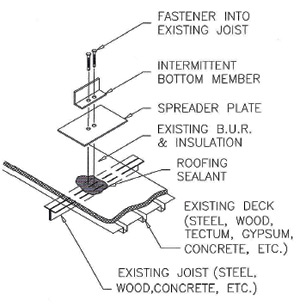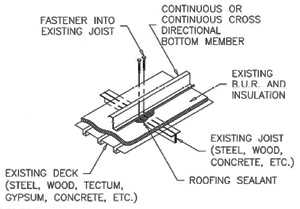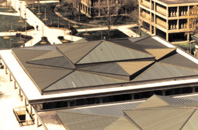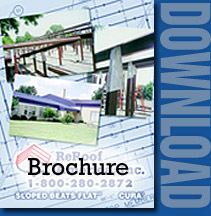Waterproofing Guidelines for the CURA Adjust-A-Web Framing System
The temporary waterproofing of an existing roof during the installation of a retrofit roof is of greatest importance. The following guidelines are RRA's suggestions, but these suggestions in no way override good construction practices and onsite requirements. (Connections of the framing system to the existing structure typically are to be designed and provided by others.)
For installation of Short Bottom Members (BM) consider the following.
1. Remove all existing gravel and debris from the top of the existing roof at the location where the new bottom member (BM) is to be installed.
 2. If holes into the existing roof are to be predrilled, use a BM for a drilling template (If Spreader Plates (SP) are to be used, use the SP instead of the BMfor a template). Before lifting the BM or SP after the holes have been drilled, mark the member's location, then lift the member and clean off any debris from the drilling. Apply roofing sealant over the pre drilled holes, covering at least 4" around each hole.
2. If holes into the existing roof are to be predrilled, use a BM for a drilling template (If Spreader Plates (SP) are to be used, use the SP instead of the BMfor a template). Before lifting the BM or SP after the holes have been drilled, mark the member's location, then lift the member and clean off any debris from the drilling. Apply roofing sealant over the pre drilled holes, covering at least 4" around each hole.
3. If self-drilling fasteners are to be used and no holes are predrilled, apply roofing sealant to the existing roof at least 4" past the new BM or SP's approximate attachment location.
4. Apply roofing sealant around all bottom edges and the bottom of the BM or SP and between the BM & SP.
5. Position the BM or SP and install the proper fasteners. After the fasteners are installed adequately cover the heads of all fasteners that penetrate the existing roof and all other penetrations with sealant.
6. The installer should assure themselves through their own analysis that the waterproofing method is adequate. RRA is not responsible for watertightness.
For installation of Continuous or Cross-Directional Bottom Members (CBM or CD) consider the following.
1. Remove all existing gravel and debris from the top of the existing roof at the location where the new bottom member (CBM ICD) is to be installed.
 2. Consideration should be given to the fact that the existing roof may not be completely flat, but the new CBM ICD is. When fasteners are installed they may lift the existing roof if the connection is in a low area thus causing a temporary leak potential. It is suggested that the bottom member run be "spudded" if needed.
2. Consideration should be given to the fact that the existing roof may not be completely flat, but the new CBM ICD is. When fasteners are installed they may lift the existing roof if the connection is in a low area thus causing a temporary leak potential. It is suggested that the bottom member run be "spudded" if needed.
3. Consideration should be given to the fact that CBM lCD's can cause a temporary dam and openings or gaps should be provided in the CBM lCD's runs.
4. If selfdrilling fasteners are to be used and no holes are predrilled, apply roofing sealant to the existing roof at least 4" past the edge of the new CBM lCD's attachment location.
5. Apply roofing sealant around all bottom edges and continuously along the bottom of the CBM/CD.
6. Position the CBM ICD and install the proper fasteners. After the fasteners are installed adequately cover the heads of all fasteners that penetrate the existing roof and all other penetrations with sealant.
7. The installer should assure themselves through their own analysis that the waterproofmg method is adequate. RRA is not responsible for watertightness.






